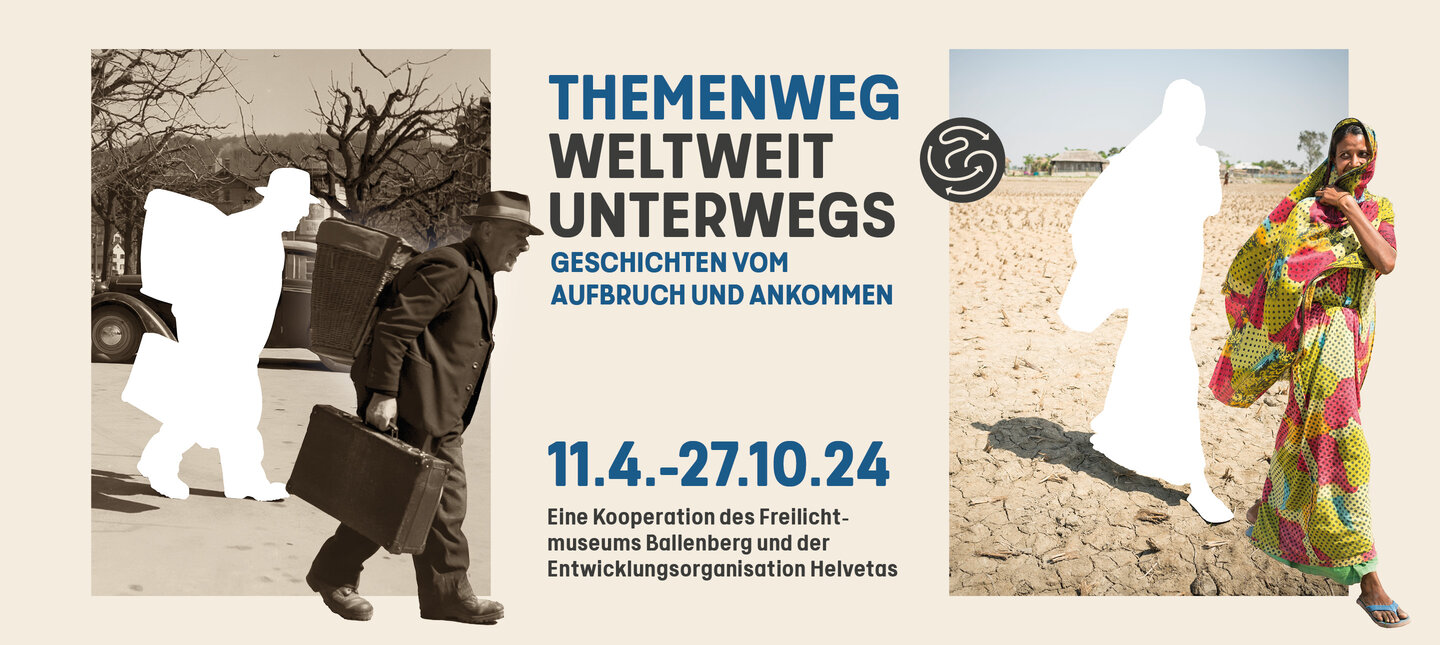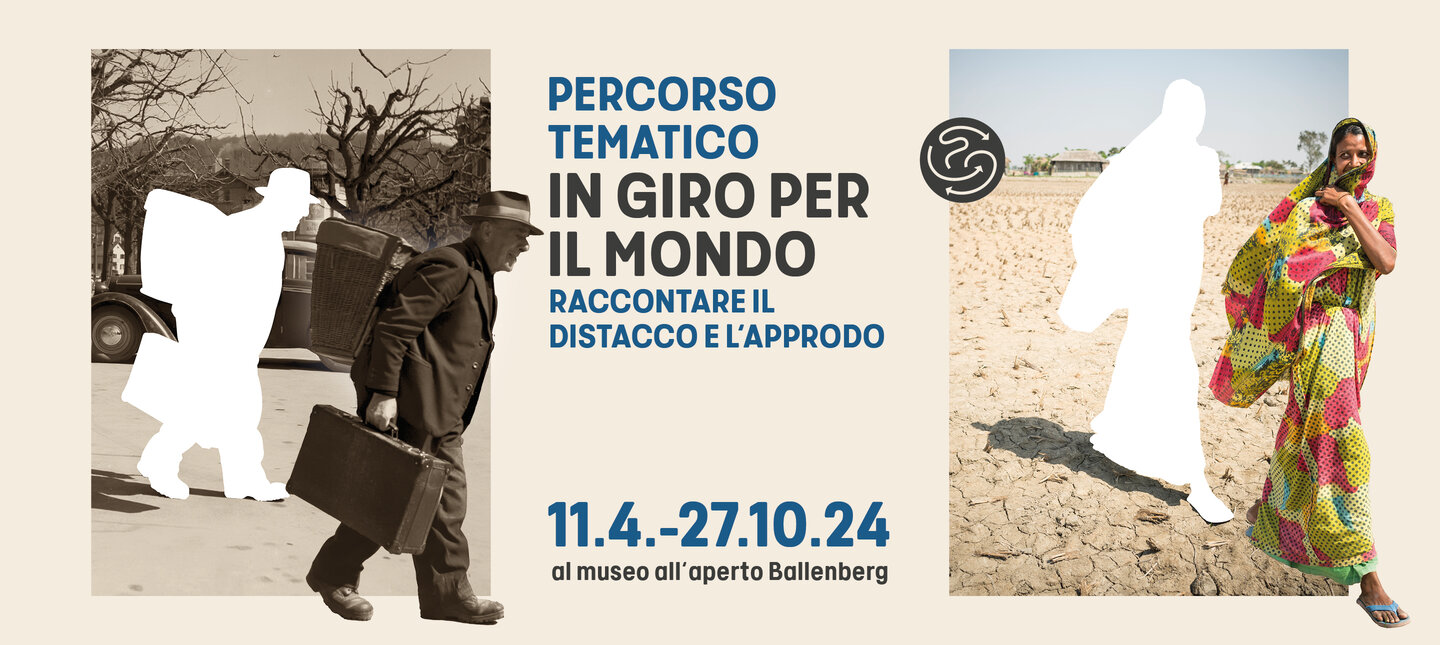Deutsch

Bei der Gründung des Bundesstaates im Jahr 1848 war die Schweiz ein armes Land. Wegen fehlender Perspektiven wanderten mehr Menschen aus der Schweiz aus als in die Schweiz ein. Im neuen Bundesstaat begannen die Kantone zusammenzuarbeiten: Sie beschlossen gemeinsame Regeln und führten den Schweizer Franken ein. Das beflügelte die Wirtschaft und die Industrialisierung.
Aber das Leben der ärmeren Familien verschlechterte sich: Wer sich in der Landwirtschaft nicht selbst versorgen konnte, besserte bisher den Lohn mit Heimarbeit auf. Doch in den neuen Fabriken konnten jetzt Maschinen Garn spinnen, Tücher weben oder Uhren herstellen. Viele Menschen vom Land zogen darum in die Städte, um dort wieder Arbeit zu finden. Oder sie entschlossen sich ganz auszuwandern.
Andererseits suchten Arbeitskräfte, Gelehrte und Geschäftsleute aus anderen Ländern nun ihr Glück in der Schweiz. In den 1880er Jahren wanderten zum ersten Mal mehr Leute in die Schweiz ein als aus.
Entdecke mehr zur Schweizer Migrationsgeschichte:
Menschen waren schon immer weltweit unterwegs. Globale Migration im grösseren Ausmass gab es ab dem 15. Jahrhundert, seit europäische Staaten ferne Länder in Amerika, Afrika und Asien kolonisierten. Das schliesst die Deportation von vielen Millionen versklavten Menschen mit ein. Millionen Menschen waren zudem global unterwegs in der Schifffahrt und im Militär. Nur einige Hunderttausend übersiedelten freiwillig dauerhaft auf andere Kontinente.
Ab dem Beginn des 19. Jahrhunderts nahm die allgemeine Mobilität zu – und damit die Vernetzung der Welt. Die Industrialisierung hatte die Transportmöglichkeiten im Verkehr revolutioniert: Eisenbahnen, Dampfschiffe und später das Automobil machten es einfacher, schneller und billiger, weite Entfernungen zurückzulegen. Das beeinflusste den weltweiten Handel, und auch die Migration von Menschen aus Europa nach Übersee stieg stark an.
Seit dem 21. Jahrhundert rückt die Welt nochmals um einiges mehr zusammen.
Vergleiche:
Luzern – Paris:
- 1850, Fahrt mit der Kutsche: 3 Tage
- 1870, Eisenbahn: 20 Stunden, 1/3 billiger
New York – Pittsburgh:
- 1800, Pferdefuhrwerk: 2 Wochen
- 1857, Eisenbahn: 1 Tag
Europa – USA
- 1867, Segelschiff: 44 Tage
- 1867, Dampfschiff: 14 Tag
Français

Lors de la création de l’État fédéral en 1848, la Suisse était un pays pauvre. En raison du manque de perspectives, le nombre de personnes qui émigraient était plus élevé que celui des personnes qui immigraient. Au sein du nouvel État fédéral, les cantons ont commencé à collaborer : ils ont établi des règles communes et instauré le franc suisse. Cette politique a stimulé l’économie et l’industrialisation.
Mais la vie des familles pauvres s’est dégradée : à la campagne, le travail à domicile avait jusqu’alors permis d’améliorer les revenus. Or dans les nouvelles usines, les machines pouvaient filer la laine, tisser des toiles ou encore fabriquer des montres. De nombreuses personnes ont donc quitté la campagne pour trouver du travail en ville. Ou elles ont décidé d’émigrer.
À l’inverse, des ouvrières et des ouvriers, des personnes savantes et des gens d’affaires d’autres pays sont venus tenter leur chance en Suisse. Dans les années 1880, le nombre d’individus qui ont immigré a, pour la première fois, dépassé celui des personnes quittant le pays.
Découvrez d’autres faits de l’histoire migratoire suisse :
La migration globale à grande échelle a commencé au XVe siècle, lorsque certains États européens ont colonisé des pays en Amérique, en Afrique et en Asie. La déportation de plusieurs millions de personnes réduites à l’esclavage en a fait partie.
Des millions de personnes se sont aussi déplacées pour la navigation ou des opérations militaires. Quelques centaines de milliers de personnes seulement se sont installées définitivement sur d’autres continents de leur plein gré.
À partir du début du XIXe siècle, la mobilité générale et, avec elle, l’interconnexion mondiale, a augmenté. L’industrialisation avait révolutionné les moyens de transport : les chemins de fer, les bateaux à vapeur et, plus tard, l’automobile ont permis de parcourir de longues distances plus facilement, plus vite et à moindre coût. Cette accélération a influencé le commerce mondial et fait croître la migration d’Européennes et d’Européens vers les pays d’outre-mer.
Depuis le XXIe siècle, le monde se rapproche encore un peu plus.
Comparaisons :
Lucerne – Paris :
-
1850, voyage en diligence : 3 jours
-
1870, train : 20 heures, 1/3 moins cher
New York – Pittsburgh :
-
1800, charrette à chevaux : 2 semaines
-
1857, train : 1 jour
Europe – États-Unis :
-
1867, voilier : 44 jours
-
1867, bateau à vapeur : 14 jour
English

When the federal state of Switzerland was established in 1848, it was very poor. Due to a lack of opportunities, more people were moving out of the country than into it. In the new federal state, the cantons started to work together: They adopted some common rules and introduced the Swiss franc. This gave a boost to the economy and industrialisation.
But the lives of poorer families only got worse; those who couldn’t make enough of a living from agriculture relied on cottage industries, such as spinning or weaving or other crafts, to boost their income. But then came new factories with machines that could spin yarn, weave cloth and make watches. As a result, many people living in the countryside moved to the cities to find work or they decided to leave the country altogether.
At the same time, there were also labourers, scholars and merchants travelling from other countries to seek their fortunes in Switzerland. The 1880s were the first time that more people entered the country than left it.
People have always moved around the world. Global migration on a larger scale has been happening since the 15th century, when European countries began colonising faraway countries in America, Africa and Asia. This also includes the deportation of many millions of enslaved people. There were also millions of people travelling the world in the shipping industry or the military. Only a few hundred thousand people relocated permanently to other continents by choice.
From the early 19th century onwards, there was an increase in general mobility – and as a result, the world became much more interconnected. Industrialisation had revolutionised transport options: Railways, steamships and, later, the motor car made it easier, faster and cheaper to travel long distances. This impacted global trade and also led to a sharp increase in the migration of people from Europe overseas.
Since the 21st century, the world has become even smaller.
Let’s compare:
Lucerne to Paris:
-
1850, by carriage: 3 days
-
1870, by railway: 20 hours, 1/3 cheaper
New York to Pittsburgh:
-
1800, horse and cart: 2 weeks
-
1857, by railway: 1 day
Europe to USA:
-
1867, by sailing ship: 44 days
-
1867, by steamship: 14 days
I am a migrant, a soul on the move,
With dreams in my heart and a spirit that proves,
That beyond borders and boundaries, I strive,
To find a place where my hopes can thrive.
With dreams in my heart and a spirit that proves,
That beyond borders and boundaries, I strive,
To find a place where my hopes can thrive.
Leaving behind the familiar and known,
I embark on a journey; with courage I've sown.
In search of new beginnings, opportunities untold,
I am a migrant, with stories yet to unfold.
I embark on a journey; with courage I've sown.
In search of new beginnings, opportunities untold,
I am a migrant, with stories yet to unfold.
Through deserts and mountains, I tread unknown lands,
Guided by hope, with determination that expands.
Across cultures and languages, I learn and adapt,
Building bridges of connection, where differences are wrapped.
Guided by hope, with determination that expands.
Across cultures and languages, I learn and adapt,
Building bridges of connection, where differences are wrapped.
I carry the weight of my history and heritage,
A tapestry of memories, an ancestral leverage.
Yet, I am more than the land from which I came,
For in migration, my identity takes on a new frame.
A tapestry of memories, an ancestral leverage.
Yet, I am more than the land from which I came,
For in migration, my identity takes on a new frame.
I bring with me skills, talents, and dreams,
Contributing to societies, stitching vibrant seams.
I am a migrant, a seeker of a better tomorrow,
Creating a future where unity can truly borrow.
Contributing to societies, stitching vibrant seams.
I am a migrant, a seeker of a better tomorrow,
Creating a future where unity can truly borrow.
In my eyes, you'll see resilience and grace,
A testament to the challenges I embrace.
For I am not defined by the borders I cross,
But by the courage within, never at a loss.
A testament to the challenges I embrace.
For I am not defined by the borders I cross,
But by the courage within, never at a loss.
So, let us embrace one another as we roam,
Recognizing the shared journey, we've known.
For in our diversity, we find strength and might,
United as humans, shining in our collective light.
Recognizing the shared journey, we've known.
For in our diversity, we find strength and might,
United as humans, shining in our collective light.
from Debabratha Gosh, Cumilla, Bangladesh
Italiano

Alla fondazione dello Stato federale nel 1848 la Svizzera era un Paese povero. Data l’assenza di prospettive, erano più le persone che emigravano di quelle che immigravano in Svizzera. Nel nuovo Stato federale i Cantoni iniziarono a collaborare: definirono norme comuni e introdussero il franco svizzero. Ciò mise le ali allo sviluppo dell’economia e dell’industrializzazione.
Parallelamente però la vita delle famiglie più povere andava sempre più peggiorando. Fino ad allora, chi non poteva provvedere al sostentamento con l’agricoltura, integrava il reddito con il lavoro a domicilio. Con l’avvento delle fabbriche, la filatura, la tessitura e la produzione di orologi venivano ormai svolte dalle macchine. Di conseguenza, le campagne si spopolarono. La gente si trasferì in città per trovare lavoro. Molti decisero di emigrare altrove.
Dall’altro lato, la Svizzera cominciò ad attirare manodopera, scienziati e commercianti in cerca di fortuna. Negli anni '80 del diciannovesimo secolo, per la prima volta l’immigrazione in Svizzera superò l’emigrazione.
Scopri altri fatti della storia della migrazione svizzera:
Gli esseri umani hanno sempre viaggiato in tutto il mondo. Nel XV secolo ha avuto inizio una migrazione globale di ampia portata in seguito alla colonizzazione di Paesi lontani in America, Africa e Asia da parte degli Stati europei. Milioni di persone furono ridotti in schiavitù e deportati. Altri milioni di persone, nel frattempo, giravano il mondo cercando impiego nel settore navale e arruolandosi nell’esercito. Solo alcune centinaia di migliaia di persone si sono trasferite per libera scelta e in maniera definitiva in altri continenti.
La mobilità generale e quindi l’interrelazione globale conobbero un incremento dall’inizio del XIX secolo. L’industrializzazione aveva rivoluzionato i trasporti: ferrovie, piroscafi e in seguito l’automobile hanno reso più semplice, veloce ed economico il percorso di lunghe tratte. Ciò ha amplificato il commercio mondiale e anche la migrazione oltremare di persone provenienti dall'Europa.
Dal XXI secolo, il mondo è sempre più vicino.
Confronta:
Lucerna – Parigi:
-
1850, viaggio in carrozza: 3 giorni
-
1870, ferrovia: 20 ore, risparmio 1/3
New York – Pittsburgh:
-
1800, carro a cavalli: 2 settimane
-
1857, ferrovia: 1 giorno
Europa – USA:
-
1867, veliero: 44 giorni
-
1867, piroscafo: 14 giorni
